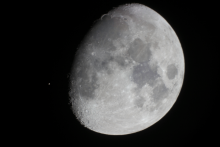Listen to today's episode of StarDate on the web the same day it airs in high-quality streaming audio without any extra ads or announcements. Choose a $8 one-month pass, or listen every day for a year for just $30.
You are here
Moon and Aldebaran
Stars are big and heavy. But they aren’t necessarily very dense. In fact, the outer layers of some stars are little more than a vacuum — a few atoms of gas with a lot of space between them.
One example is Aldebaran, the bright orange star that marks the eye of Taurus, the bull. It’s to the upper left of the Moon this evening, and to the lower right of the Moon tomorrow night.
All stars are big balls of gas, so they don’t have a rigid structure. But they’re massive, so they have a strong gravitational pull. Gravity squeezes the star’s core tightly, making temperatures high enough to sustain nuclear fusion.
Aldebaran has completed the first round of its fusion reactions. When that round ended, the core got smaller and denser — hundreds of times denser than water. The star’s outer layers, on the other hand, got puffier. Today, the star is almost 45 times the Sun’s diameter — and 85,000 times its volume.
Recent work says Aldebaran is only a bit more massive than the Sun. So when you compare its “weight” to its volume, you find that Aldebaran’s outer layers are really spread out. On average, they’re less than a hundredth of a percent as dense as Earth’s atmosphere at sea level. And the outermost layers are even thinner.
So much of Aldebaran is pretty insubstantial — not much more than a vacuum. The star is so big, though, that its material adds up — making it a bold presence in the galaxy — and in the night sky.
Script by Damond Benningfield




